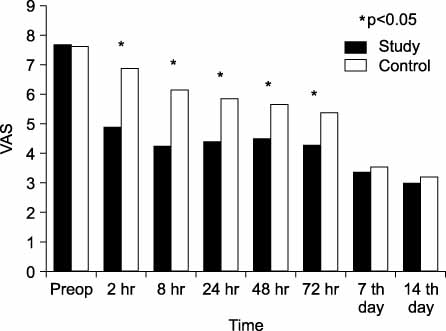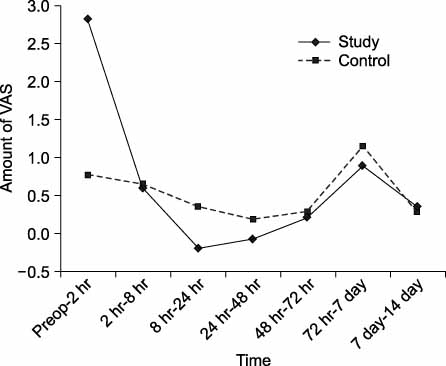J Korean Orthop Assoc.
2008 Oct;43(5):638-642. 10.4055/jkoa.2008.43.6.638.
The Effect of Intraoperative Periarticular Local Injection in Total Knee Arthroplasty
- Affiliations
-
- 1Department of Orthopaedic Surgery, SoonChunHyang University College of Medicine, Cheonan, Korea. chros@schch.co.kr
- KMID: 2186427
- DOI: http://doi.org/10.4055/jkoa.2008.43.6.638
Abstract
-
PURPOSE: To assess the effect of intraoperative periarticular local injection in total knee arthroplasty.
MATERIALS AND METHODS
We studied 36 patients (72 knees) that underwent bilateral simultaneous primary total knee replacement between October, 2005 and December, 2006. The study group (36 ipsilateral knees) received a 60 ml intraoperative periarticular injection containing a mixture of bupivacaine, epinephrine, morphine, ketorolac, and saline. The injection was made in the posterior capsule and surrounding soft tissues, muscles, and subcutaneous tissues. The control group (36 contralateral knees) did not receive this injection. Postoperative pain levels were evaluated at 2, 8, 24, 48, and 72 hours and 7 and 14 days using the Visual Analogue Scale (VAS). Hemo-vac drains were evaluated at postoperative days 1, 2, 3, 4, and 5.
RESULTS
There was no side-to-side difference of VAS in both the study group and the control group according to the side chosen. Preoperative VAS was not significantly different between the two groups. There was a significant decrease in the VAS of the study group patients at 2, 8, 24, 48, and 72 hours postoperative, with the most significant decrease seen at 2 hours. Postoperative bleeding was significantly lower in the study group on the first day, with no difference seen thereafter between the two groups.
CONCLUSION
Intraoperative periarticular local injection provides better immediate postoperative pain control in total knee arthroplasty.
Keyword
MeSH Terms
Figure
Reference
-
1. Badner NH, Bourne RB, Rorabeck CH, Doyle JA. Addition of morphine to intra-articular bupivacaine does not improve analgesia following knee joint replacement. Reg Anesth. 1997. 22:347–350.
Article2. Badner NH, Bourne RB, Rorabeck CH, MacDonald SJ, Doyle JA. Intra-articular injection of Bupivacaine in knee-replacement operations. Results of use for analgesia and for preemptive blockade. J Bone Joint Surg Am. 1996. 78:734–738.3. Bourne MH. Analgesics for orthopedic postoperative pain. Am J Orthop. 2004. 33:128–135.4. Busch CA, Shore BJ, Bhandari R, et al. Efficacy of periarticular multimodal drug injection in total knee arthroplasty A randomized trial. J Bone Joint Surg Am. 2006. 88:959–963.5. Calmet J, Estene C, Boada S, Giné J. Analgesic effect of intra-articular ketorolac in knee arthroscopy: companison of morphine and bupivacaine. Knee Surg Sports Traumatol Arthrosc. 2004. 12:552–555.6. Cho WS, Kim MY, Seol ES, Youm YS, Yoon YS. The effect of intraoperative regional analgesic injection in total knee arthroplasty. J Korean Orthop Assoc. 2006. 41:989–993.
Article7. Crawford CH 3rd, Malkani AL. Patient-controlled analgesia for total joint arthroplasty. Instr Course Lect. 2007. 56:115–119.8. Gatt CJ Jr, Parker RD, Tetzlaff JE, Szabo MZ, Dickerson AB. Preemptive analgesia: its role and efficacy in anterior cruciate ligament reconstruction. Am J Sports Med. 1998. 26:524–529.9. Han CD, Choi YJ, Yang IH. The effect of inta synovial ropivacaine and morphine injection on postoperative pain after total knee arthroplasty. J Korean Knee Soc. 2006. 18:158–166.10. Klasen JA, Opitz SA, Melzer C, Thiel A, Hempelmann G. Intraarticular, epidural, and intravenous analgesia after total knee arthroplasty. Acta Anaesthesiol Scand. 1999. 43:1021–1026.
Article11. Kligman M, Bruskin A, Sckliamser J, Vered R, Roffman M. Intra-synovial, compared to intra-articular morphine provides better pain relief following knee arthroscopy meniscectomy. Can J Anaesth. 2002. 49:380–383.12. Lombardi AV Jr, Berend KR, Mallory TH, Dodds KL, Adams JB. Soft tissue and intra-articular injection of bupivacaine, epinephrine, and morphine has a beneficial effect after total knee arthroplasty. Clin Orthop Relat Res. 2004. 428:125–130.
Article13. Mallory TH, Lombardi AV Jr, Fada RA, Dodds KL, Adams JB. Pain management for joint arthroplasty: preemptive analgesia. J Arthroplasty. 2002. 17:4 Suppl 1. S129–S133.
Article14. Mauerhan DR, Campbell M, Miller JS, Mokris JG, Gregory A, Kiebzak GM. Intra-articulr morphine and/or bupivacaine in the management of pain after total knee arthroplasty. J Arthroplasty. 1997. 12:546–552.15. Parvataneni HK, Ranawat AS, Ranawat CS. The use of local periarticular injections in the management of postoperative pain after total hip and knee replacement: a multimodal approach. Instr Course Lect. 2006. 56:125–131.16. Sinatra RS, Torres J, Bustos AM. Pain management after major orthopaedic surgery: current strategies and new concepts. J Am Acad Orthop Surg. 2002. 10:117–129.
Article17. Tanaka N, Sakahashi H, Sato E, Hirose K, Ishii S. The efficacy of intra-articular analgesia after total knee arthroplasty in patients with rheumatoid arthritis and in patients with osteoarthritis. J Arthroplasty. 2001. 16:306–311.
Article
- Full Text Links
- Actions
-
Cited
- CITED
-
- Close
- Share
- Similar articles
-
- Short Term Analgesic Effects of Intraoperative Periarticular Injection in Total Knee Arthroplasty
- Comparison of the postoperative analgesic effect for infiltration between the popliteal artery and the capsule of the posterior knee and that of periarticular multimodal drug injection in total knee arthroplasty: retrospective study in the immediate postoperative period
- Is Suction Drainage Necessary after Total Knee Arthroplasty?
- Effect of Periarticular Injection on Knee Pain in Patients with Knee Osteoarthritis
- Periarticular Injection with Corticosteroid Has an Additional Pain Management Effect in Total Knee Arthroplasty



